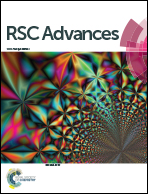Study of structural and conduction properties of Co3O4-doped corundum-type Mg4Ta2O9 ceramics
Abstract
The effects of structural distortion on charge transport, crystal defects and relaxor response are studied for corundum-type (Mg1−xCox)4Ta2O9 (x = 0–0.5) ceramics. XRD analysis reveals that A-site substitution takes place up to x = 0.3, whereas further increasing the Co concentration causes a charge imbalance to be created by heterovalent substitution of Co3+ in place of Mg2+. In order to maintain the charge neutrality, B-site substitution takes place for x = 0.4 and 0.5. This paper has established a relation between polyhedral distortion and the conduction mechanism in ceramics. Impedance measurements were made on the prepared samples over a wide range of temperatures (30–450 °C) and frequencies (100 Hz to 1 MHz). Heterovalent A-site substitution and cationic vacancies gradually increase the polyhedral distortion, leading to a decrease in the activation energy for the conduction process. B-site substitution reduces the cationic vacancies and strengthens the activation energy. For samples having x = 0.1–0.4, the barrier-hopping mechanism dominates, whereas for x = 0 and 0.5, the polaron conduction mechanism plays the dominant role in the ac conduction process. Moreover, the samples having x = 0.1 and 0.2 exhibit an additional quantum tunnelling process at low temperatures due to the inadequacy of the energy for ionic conduction. In complex electric modulus analysis, broad peaks are observed in the M′′ versus frequency plots, which are ascribable to the existence of several potential minima for central cations within the octahedron.


 Please wait while we load your content...
Please wait while we load your content...